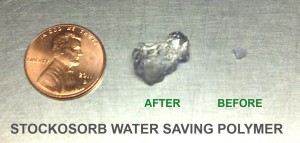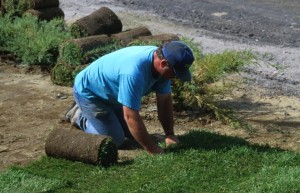WATERING
Water the sod immediately after installation until it’s completely soaked, but not puddled ABOVE the sod. Initially, apply at least 1″ of water so the soil underneath is very wet. Pull back a corner of sod to verify your watering is penetrating the underlying soil. Make sure the water is getting to all the areas of your lawn and no corners or edges are missed by your sprinklers. Weather conditions will dictate the frequency and amount of water to apply. It is critical to keep the underlying soil moist for two weeks or until your turf is well rooted.
As the turf becomes more established, begin deeper, less frequent water applications to promote deeper rooting and hardier turf.
Be sure your new turf grass has enough moisture to survive hot, cold, dry and windy conditions. Generally speaking, as the root system grows deeper, irrigation frequency should be reduced.
GENERAL RULES FOR ESTABLISHING NEW TURF
WEEK 1 – 7AM + 11AM + 2 PM
If the soil remains moist and absolutely no turf wilt is observed, eliminate the 11:00 watering.
WEEK 2 – 7AM + 2PM
If the soil remains moist and absolutely no turf wilt is observed, eliminate the 2:00PM watering.
WEEKS 3 & 4 – 7AM
If the soil remains moist and absolutely no turf wilt is observed, water every other day.
Eventually taper back to once every two or three days.
Adjust according to weather and season – water more frequently during warm or dry weather.
Turn off water if it’s windy, as the water evaporates at a much higher rate.
Do not water sod between 8 PM and 4 AM, as this can promote turf disease.
FOOT TRAFFIC
During the first couple of weeks after installation, keep traffic off your newly planted turf grass as much as possible. Your new turf grass needs time to firmly knit the roots with the soil. If you have properly watered your newly-laid turf grass, it will be moist and soft. Traffic will create indentures and destroy your smooth grade.
TROUBLESHOOTING
If DRY SPOTS appear in the lawn during the afternoon, the irrigation time should be increased. If dry spots persist, an irrigation uniformity problem is likely, and an additional sprinkler head may be required.
BROWN LAWN areas are most commonly caused by one of three types of problems: Improper watering, burn, or disease. Check for watering and burn problems first before treating for disease.
BROWN SPOTS caused by a burn will result from pet urine, over-fertilization, gasoline spills, etc. Burn spots are distinguished from other types of damage by their “total kill” straw-yellow color. If a burned area is thoroughly flushed with water in the early stage of damage some recovery may occur. Otherwise reseeding or sodding may be necessary. However, with bluegrass, if you are patient, the area will fill itself in. It will just take some time. With fescue, overseeding or re-sodding will be necessary, as it will NOT fill itself in.
To check for LACK OF WATER use a screwdriver or knife to probe the brown areas of your lawn as well as the healthy green areas. If the brown area is more difficult to penetrate then a lack of water is likely. This is usually the result of poor sprinkler spacing or sprinkler malfunction. Saturate the area with a hose as soon as possible and continue to provide supplemental water until the sprinklers are repaired.
EXCESS WATER can cause turf to die by suffocating the plants roots or rotting its crown. This generally occurs in low spots or shady areas. Check for muddy soil, algae crusts, or slimy rotting grass. To correct problems in the shade, reduce irrigation time to that area or replace the sprinklers with lower volume heads. Low spots must either be raised or set up to drain. A French drain might need to be installed, which can be done by local landscape contractor.
DISEASES are almost always related to heat and moisture. However, poor irrigation practices can also promote disease development. The longer moisture stays in the turf foliage the greater the disease risk. Therefore, do not water at night, (between 6 pm and 4 am) since the lawn will stay wet until morning. It is best to irrigate between 6 am and 8 am. Early morning watering reduces evaporation.


